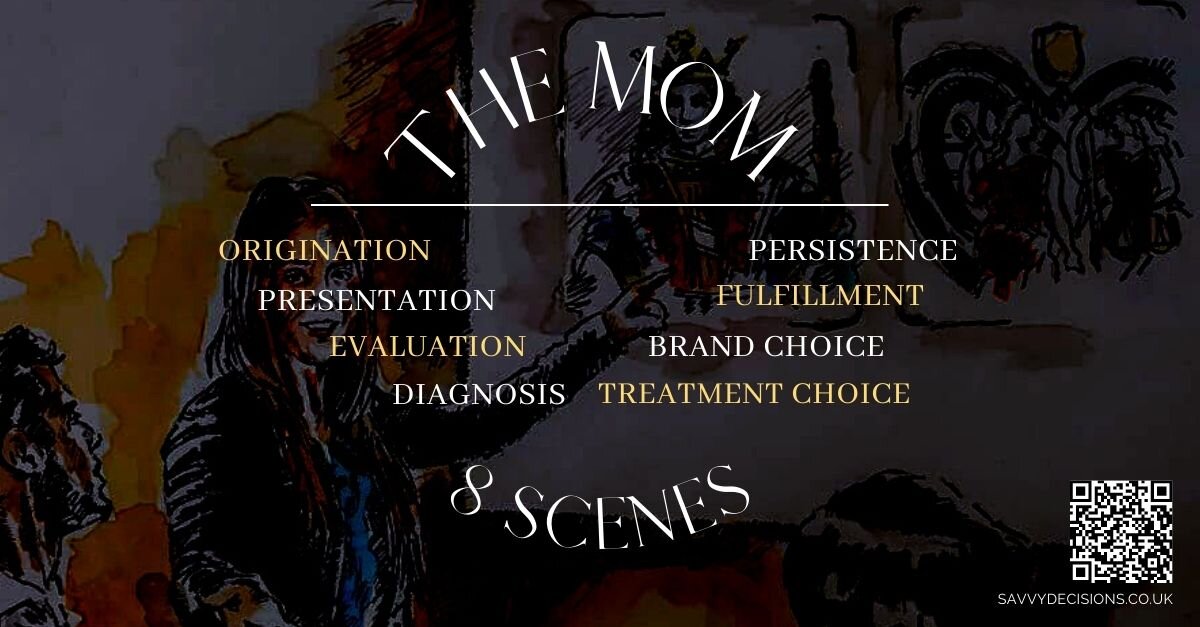Construct The Mom
Construct The MoM scenes and seek insightful answers to some critical questions
A market opportunity map (MOM) captures any interaction that a customer has with a business, its products or services.
Based on my own experience refining MOMs over the past 19 years in Big Pharma, I learned that getting the best outcome is not merely a matter of putting in the effort. The most important components are challenging underlying assumptions, selecting the right methods and sources of data, asking the right questions, using the most appropriate techniques to analyze data, carefully choosing the parameters and factors to exclude to qualify insights, identifying gaps and opportunities, and picking the leadership required to steer the research team.
In what follows, I will outline the key principles that I learned from creating my own “MOM.”
I recommend that you begin by visualizing the journey as a movie that contains different scenes. What does scene 1 look like? Based on the plot, who should be included in the scene? List all of the actors (stakeholders) involved in the scene and then describe who they are, their pain points, what motivates them, what is holding them back, and what emotions typically arise in their daily work.
What is happening in this scene? What are the characters doing? Which channels do they use to communicate with each other and collect information? Where should the scene take place – an office setting or perhaps a café?
Once you have a clear vision of the first scene, move onto the next. My best advice is to always consider what the characters could be doing, even if they are not the focus of the scene.
Said another way, every MOM is a series of interlocking scenes that builds a story.
1) Start by drafting your scenes based on the insights of a cross-functional team. By “insights,” I mean key information that enables you to determine why stakeholders behave the way they do. Ask them to share the insights they gained during the last year and the context within which they arose. This will give you a good sense of their reliability and potential biases.
2) Ask the team to specify how each insight will impact the businesses’ overall health. The more insights that you gather with the potential for high impact, the more you can make a significant difference to the bottom line. Do not worry if the majority of insights are low impact. That simply means there is a lot of work ahead of you and you need to identify deeper insights that will make a difference.
3) Start to plot insights in relevant scenes and study how they influence the behaviors and attitudes of each stakeholder.
4) Sort these insights under each of the MOM’s 8 blocks and then ask yourself: Is it real and deep enough? The best test is to substitute the name of the brand with something else and determine whether it still makes sense. If yes, then it’s generic.
5) Roll out the film and watch the story unfold in its entirety starting from scene 1. Ask yourself whether the storyline is intact and connected? Does scene 5 cohere with 1? Is the full movie original or is it generic?
Next, identify the gaps in each scene. At the end you should have a story that is full of rich and detailed interactions that unfolded during master scenes (8 blocks). Perhaps you can capture a greater depth of information by asking more questions to complete the picture.
6) Throughout this process, you will unveil key information about your competitors and your brand. Map them into each block. Bear in mind that these insights should come from your stakeholders – how they perceive your brand – and your competitors. They should not come from your company, as there is a tendency to overestimate your brand’s benefits and underestimate your competitors.
7) You will most likely need to complete a complementary project to identify and fill in gaps. For this, you should use a variety of research methods. Since each method has its strengths and weaknesses, do not depend on one. To get the best out of this process, don’t be passive – waiting for data to arrive at your desk – take ownership and leadership of your project.
Broadly speaking, when you construct the scenes and seek answers to the questions listed above, keep in mind that there is no such thing as rational thinking when it comes to consumer behavior. Consider the following scenario. When you are walking down the aisle of the supermarket, your inner monologue may go something like this: “Oh yum cookies! I’m on a diet but these ones are gluten free and I’ve had a hard day. I will buy it!”
My point is that we continuously swap between different value systems when we buy, rationalizing and justifying our behaviors. In that same way, when you are identifying stakeholders’ behaviors, don’t make assumptions; ask them how they behave in these situations. Get the real behavior, not the rational one that is a matter of expectation. This is critical to ensure you are constructing an original not a generic MOM (patient journey).

